ScatteredSurface (FPScript)
Models a surface using the Natural Neighbor method for the sampling points specified as a space curve and evaluates this at definable grid points.
Syntax
ScatteredSurface(SpaceCurve, GridX, GridZ, SamplingMode)
or
ScatteredSurface(Y, X, Z, GridX, GridZ, SamplingMode)
The syntax of the ScatteredSurface function consists of the following parts:
Part |
Description |
||||||
|---|---|---|---|---|---|---|---|
SpaceCurve |
The space curve that contains the sampling points of the surface to be interpolated. Permitted data structures are space curve. All numeric data types are permitted. For complex data types the absolute value is formed. If the argument is a list, then the function is executed for each element of the list and the result is also a list. |
||||||
Y |
A data series with the Y component of the space curve that contains the sampling points of the surface to be interpolated. Permitted data structures are data series und signal. All numeric data types are permitted. For complex data types the absolute value is formed. If the argument is a list, then the first element in the list is taken. If this is also a list, then the process is repeated. |
||||||
X |
A data series with the X component of the space curve that contains the sampling points of the surface to be interpolated. Permitted data structures are data series und signal. All numeric data types are permitted. For complex data types the absolute value is formed. If the argument is a list, then the first element in the list is taken. If this is also a list, then the process is repeated. |
||||||
Z |
A data series with the Z component of the space curve that contains the sampling points of the surface to be interpolated. Permitted data structures are data series und signal. All numeric data types are permitted. For complex data types the absolute value is formed. If the argument is a list, then the first element in the list is taken. If this is also a list, then the process is repeated. |
||||||
GridX |
A data series with the X values of the grid for which the modeled surface is to be evaluated. Permitted data structures are data series. All numeric data types are permitted. Void values are not permitted in this argument. For complex data types the absolute value is formed. If the argument is a list, then the first element in the list is taken. If this is also a list, then the process is repeated. |
||||||
GridZ |
A data series with the Z values of the grid for which the modeled surface is to be evaluated. Permitted data structures are data series. All numeric data types are permitted. Void values are not permitted in this argument. For complex data types the absolute value is formed. If the argument is a list, then the first element in the list is taken. If this is also a list, then the process is repeated. |
||||||
SamplingMode |
Specifies how the calculated surface is to be sampled. The argument SamplingMode can have the following values:
If the argument is a list, then the first element in the list is taken. If this is also a list, then the process is repeated. |
Remarks
The result always has the data type 64-bit floating point.
The result has the same unit as the argument SpaceCurve.
The result is a signal series with a Z component (surface) that contains the arguments GridX and GridZ as the X or Z component.
The space curve must contain at least 3 points and cannot be degenerated, i.e. the X and Z values must be arranged in such a way that these span a surface.
The X and Z component of the data set cannot contain void values. Void values in the Y component are handled as missing sampling points.
The unit of the X or Z component of the result corresponds to that of the argument GridX or GridZ.
The following illustrations show a Natural Neighbor surface and the data it is based on:
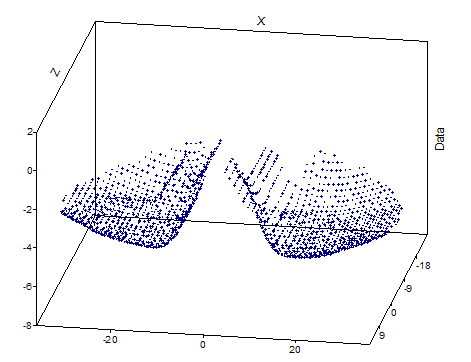
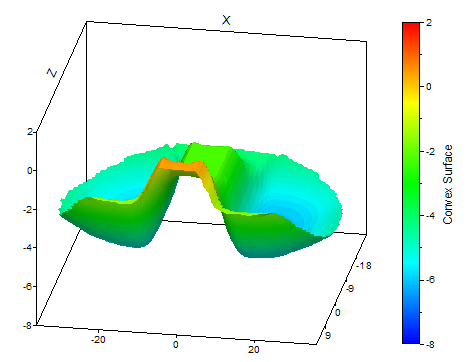
Available in
FlexPro Basic, Professional, Developer Suite
Examples
Dim x = Series(0,2 * PI, 2 * PI / 100)
Dim data = Signal(sin(x) * cos(x), cos(x), sin(x))
ScatteredSurface(data, (100, -1, 0.02), (100, -1, 0.02), SURFACE_CONVEX)
Models a convex surface using the natural neighbor method.
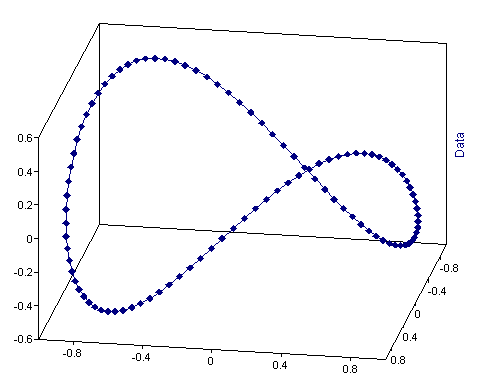
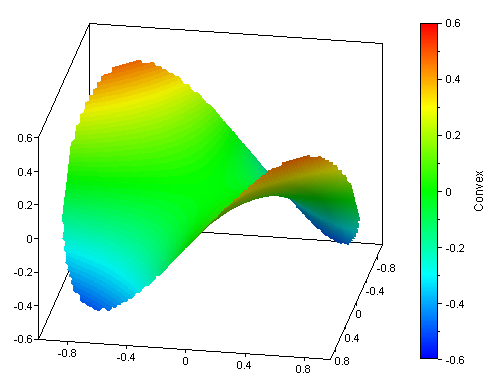
ScatteredSurface(data, (100, -1, 0.02), (100, -1, 0.02), SURFACE_RECTANGULAR)
Models a rectangular surface using the natural neighbor method.
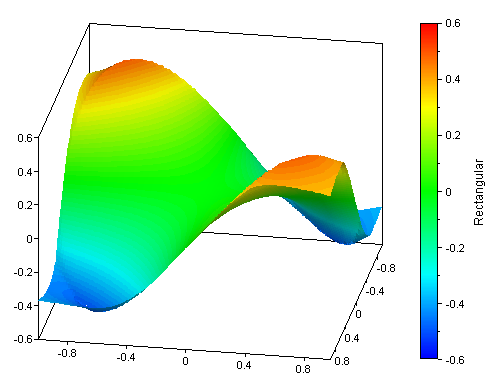
See Also
Surface Interpolation Analysis Object
Curve Transformation Analysis Object
2D Approximation Analysis Object
References
[1] "Watson, Dave": "nngridr - An Implementation of Natural Neighbor Interpolation". "Dave Watson Publisher, Claremont, Australia",1994.
[2] "Watson, Dave": "Contouring: - A Guide To The Analysis and Display of Spatial Data". "Pergamon Press",1992.ISBN 0-08-040286-0.
You might be interested in these articles
You are currently viewing a placeholder content from Facebook. To access the actual content, click the button below. Please note that doing so will share data with third-party providers.
More InformationYou need to load content from reCAPTCHA to submit the form. Please note that doing so will share data with third-party providers.
More InformationYou are currently viewing a placeholder content from Instagram. To access the actual content, click the button below. Please note that doing so will share data with third-party providers.
More InformationYou are currently viewing a placeholder content from X. To access the actual content, click the button below. Please note that doing so will share data with third-party providers.
More Information